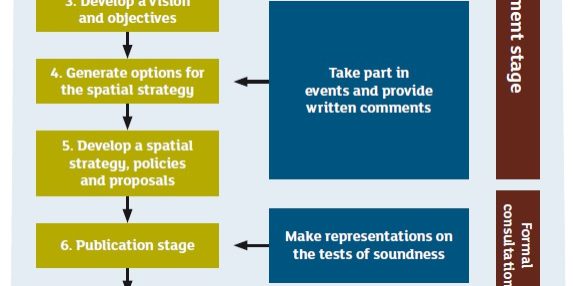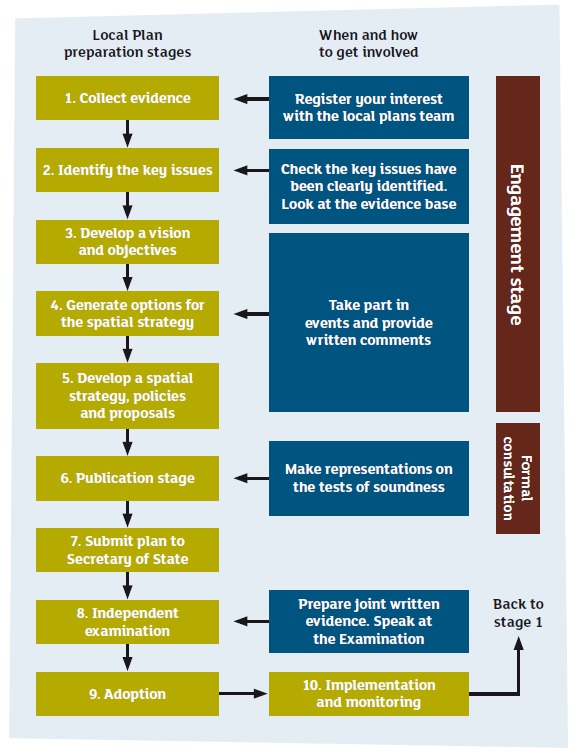Local Plans: have your say

Last modified:
15th February 2022

Local Plans set out the big decisions on planning for the future of your community and land. They outline the long-term strategy for each planning authority. England’s planning system is designed to ensure that future development is always in the public interest and stops speculative development.
Local Plans set out the strategic priorities for development of an area and cover housing, commercial, public and private development, including transport infrastructure, along with protection for the local environment. They comprise a series of documents that should set out clear guidance on what development will and won’t be permitted in your area.
Have your Say
Step One: maximise your influence by attending events or workshops and, most importantly, respond in writing to consultations.
Step Two: the local planning authority is not required legally to consult the public at this stage. If they do, comment on the issues, visions and objectives.
Step Three: understand the spatial strategy and the Sustainability Appraisal.
This is a key stage to comment and influence the plan.
Step Four: understand policies and proposals.
You may have an opportunity to comment or you may not see the full text of the Local Plan until it’s published.
Step Five: responding to the formal consultation on the pre-submission draft version of the Local Plan.
Once the local planning authority is happy with its Local Plan it must publish it for a formal consultation period of at least six weeks and make it available at the council offices, other appropriate locations and on its website. At this stage formal representations can be made in writing or electronically e.g. via a website or email.
This is your last chance to have your say on the contents of the Local Plan. Even if you have made comments at an earlier stage it will be worth looking again to see if your comments have been taken on board. If not, you may want to make your comments again as a formal representation. Importantly, all representations made at the publication stage are provided to the inspector who examines the plan. If you don’t respond to this version you will not have an opportunity to comment or speak at the Examination.
Commenting on the tests of soundness
Local Plans are required to meet the tests of soundness. This means they should be: positively prepared; justified; effective; and consistent with national policy.
Questions to ask yourself:
- Is the plan positively prepared?
Does the plan seek to meet the local needs for housing, land for businesses, community facilities, infrastructure (transport, water, energy), education, shops, facilities for sport and leisure etc., which have been identified through the studies which make up the evidence base? - Is it justified?
Is the chosen strategy the best one compared with the alternatives considered? Is it clear how the Sustainability Appraisal has informed the plan (the Sustainability Appraisal report should set this out, and can help you to compare alternative options)? Has the plan been prepared with participation of the community? Is it clearly founded on evidence, backed up by facts? - Is it effective?
Is there information on how the plan will be delivered during its life time (e.g. an ‘implementation plan’)? Does this say whether other delivery partners (e.g. strategic rail and highway authorities, the Environment Agency, water companies) are signed up to the plan? Is there an indication of when sites will come forward? Is it clear how the plan will be monitored? Is it flexible – able to deal with changing circumstances (e.g. what if a big site doesn’t come forward for development when expected)? - Is it consistent with national policy as set out in the National Planning Policy Framework?
Step Six: submission version of the Local Plan.
Once the local planning authority has considered all the representations received at the publication stage, it can amend the plan before submitting it to the Secretary of State to be considered by an independent inspector at an Examination. The local planning authority is required to provide a written summary of all the issues raised, both during the engagement stage and publication stage, to the inspector. They must also say how issues raised at the publication stage have been addressed in the plan.
Step Seven: take part in the Examination.
The Local Plan will be considered by an independent Planning Inspector who will assess whether the Plan has been prepared ensuring ‘duty to co-operate’, legal and procedural requirements. The Inspector will also consider all the representations made and the evidence prepared by the local planning authority. The Inspector will decide if a hearing is required and, if so, what issues will be covered. The Inspector must focus on the soundness of the plan.
If your objections have not been overcome at the submission stage you may decide to register to speak or make further comment at the Hearing.
Step Eight: Inspector’s recommendation, approval and adoption.
Following the Examination, the Inspector will make a recommendation to the Secretary of State and the local planning authority. The Inspector may find the Plan ‘unsound’ in which case the local planning authority cannot adopt it without significant changes requiring further consultation and re-examination.
When adopted, look out for planning applications implementing the Local Plan and influence the quality of development in your area.
Read more about planning and how to respond to planning applications.
